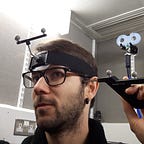Haptic Art
Article of speculations, issue №3. How do we create art that solely relies on the feeling of touch, or can we make touch experience beautiful and transcendent?
Do you even art?
Overall, which senses contribute to THE ART? It’s mainly vision and hearing*. There are poetry and fiction, which doesn’t necessarily rely on those external senses but happen only in our brain through words. There is, again, modern art of the XX century, which focused not on creating visual beauty but on directly creating new meanings and new concepts. This is all cool, but let’s go back to the human senses and ask: why not touch?
First, what constitutes art anyway (a non-trivial question)? Well, even Greek muses were not all about art: they had muses of history and astronomy, and, moreover, the word “art” started meaning this usual aesthetic stuff only after the XVII century. What is art now?
Art is: creative skill and imagination => producing work = > to be appreciated (for their beauty or emotional power). [Google “art definition”]
Can we make an art-form that is totally appreciated through touch?** Some philosophical guys were saying that art should be “transcendent”, and touch can never be that! Probably, because they considered art to be divine, connected with spirit and not with body, however touch — is obviously 100% body and therefore cannot be transcendent! Nevertheless, this notions of divinity and spirit are outdated, body and soul is one. I believe that touch can be art, it can bring transcendent experiences and be beautiful. It provides multi-layered information, it is emotionally charged, it can be perceived both passively and actively, it can be given as a spatial image, or can be extended through time. Nothing stops it from becoming an art-form!
Touch art
First of all, what is out there?
- Immediate idea coming to mind is of massage and sex, which we definitely appreciate for their emotional power. Are they art? Emotionally charged but not conceptually?
- Creating 3D objects in real or virtual space that replicate art masterpices. for example 3D printing or vibrotactile gloves.
- Hapto-visual art pieces, made with touch in mind, e.g. inclusive Haptic encounter by Elisabeth Higgins O’Connor, or Haptic art — a UK-based art collective specialising in textile artworks, or audio-visuo-haptic art piece at Tate Modern by Ultrahaptics.
- Subpac is bringing music to deaf people through their haptic vest
- definitely something else…***
.NOT MUCH. (although there is definitely a lot of great haptic design)
So let’s create.
Three potential approaches:
- Objects: layered object(s) with multiple different textured materials, which you actively explore.
- Haptic devices which give you sensations while you are a passive perceiver. How fine should/can the tech be for a meaningful artistic experience?
- Combination thereof. Interactive haptic objects/devices.
What should the art-work have? It should bring new ideas, although building upon previous experience, provide pleasant feelings, sometimes a bit unpleasant, unexpected turns, resolutions, development or story, conceptually understandable, rhythmical.**** Go and do it, it’s easy!
________________________________________________________
* Division of art
- Classical arts: painting, sculpture, architecture;
- Performing arts: music, theatre, dance, film;
- Interactive media arts;
- Poetry, fiction (?) and other ones based on words;
- Some other random art-forms
** On the left-hand side, the act of creation has definitely a lot of haptics, for example in sculpture.
*** In addition to properly haptic pieces of arts, there is a notion of “haptic visuality” in aesthetics, but it is more about paintings having tactile properties.
**** Psychedelics improve one’s perceptions and brain connections, can they make Touch more of an art?
